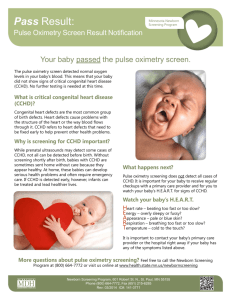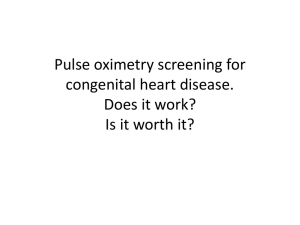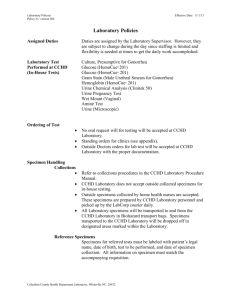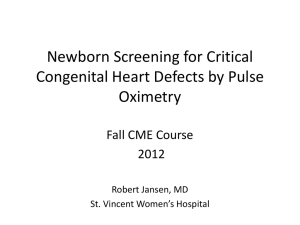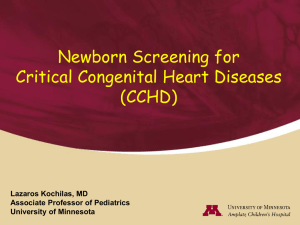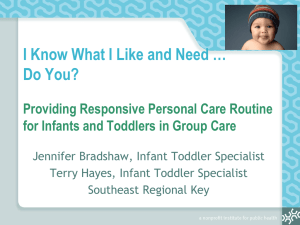JAMA Pediatrics Journal Club Slides
advertisement
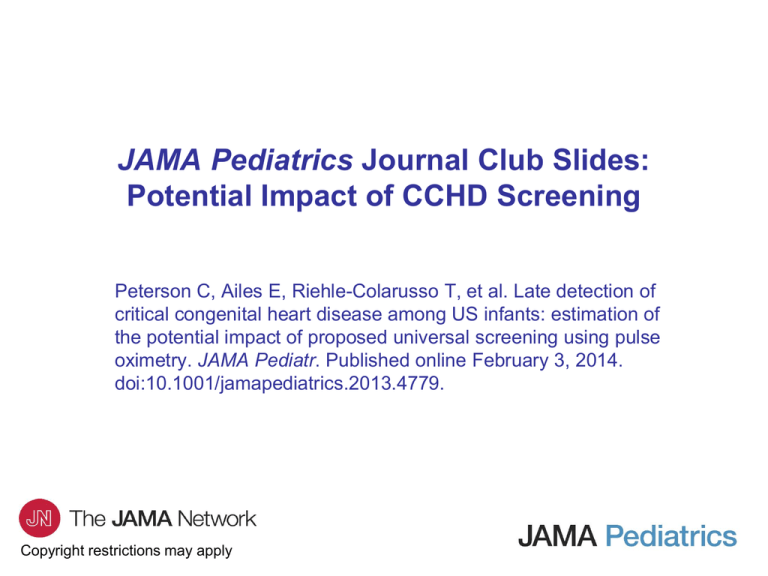
JAMA Pediatrics Journal Club Slides: Potential Impact of CCHD Screening Peterson C, Ailes E, Riehle-Colarusso T, et al. Late detection of critical congenital heart disease among US infants: estimation of the potential impact of proposed universal screening using pulse oximetry. JAMA Pediatr. Published online February 3, 2014. doi:10.1001/jamapediatrics.2013.4779. Copyright restrictions may apply Introduction • Congenital heart defects affect approximately 1% of live births in the United States; 25% are considered critical congenital heart disease (CCHD), requiring surgery or catheterization at or before age 1 year. • CCHD was added to the US Recommended Uniform Screening Panel for Newborns in 2011. – Screening performed using pulse oximetry. – Screening recommended within 24-48 hours of birth. • Study Objectives – To estimate proportion of US infants with clinically validated, nonsyndromic, screening-detectable CCHD whose condition was detected late (>3 days after birth). – To investigate clinical and demographic factors associated with late detection. Copyright restrictions may apply Methods • Study Design: National Birth Defects Prevention Study (NBDPS). – Ongoing, population-based, case-control study of >30 major birth defects. – CCHD confirmed by echocardiography, catheterization, surgery, or autopsy. – Chromosomal or single-gene disorders excluded. – Clinical data obtained from medical records. – Demographic characteristics, exposures, and medications from maternal interview. • Setting – Infants born from January 1, 1998, through December 31, 2007. – Mothers lived in sampled states (Arkansas, California, Georgia, Iowa, Massachusetts, New Jersey, New York, North Carolina, Texas, Utah) at time of delivery. • Patients – Live-born infants with nonsyndromic, clinically verified CCHD. Copyright restrictions may apply Methods • Outcome: Late CCHD detection. – No evidence of diagnostic echocardiography prenatally or ≤3 days of birth. • Analysis – Assessed timing of CCHD diagnosis (prenatal, postnatal, and autopsy). – Poisson multivariable regression model with robust sandwich error variance used to examine factors associated with late detection, including: From birth defects surveillance data – NBDPS study site. – Presence of extracardiac defects (ie, major defects in organ systems outside the heart). – CCHD type. – Gestational age at delivery. – Estimated date of delivery year. Copyright restrictions may apply From NBDPS maternal interview data – – – – – – – – – – First-degree family history of CHD. Plurality. Maternal race/ethnicity and education. Maternal age at delivery. Pregestational diabetes. Prepregnancy body mass index. Preexisting hypertension. Fertility treatments. Previous pregnancy losses. Trimester of the first prenatal care visit. Results Derivation of Study Sample of Infants With CCHD in the NBDPS, 1998-2007 Copyright restrictions may apply Results Copyright restrictions may apply Results • In multivariable analysis, late detection varied significantly by the following: – CCHD type: Adjusted prevalences of late detection among infants with Ebstein anomaly, single ventricle, critical pulmonary stenosis, interrupted aortic arch, tetralogy of Fallot, double-outlet right ventricle, truncus arteriosus, total anomalous pulmonary venous return, and coarctation of the aorta were each significantly greater than among infants with hypoplastic left heart syndrome. – Study site: Two-fold difference between the sites with the lowest and highest adjusted prevalence of late detection (adjusted prevalence ratio = 2.09; 95% CI, 1.66-2.63). – Presence of extracardiac defects: Adjusted prevalence of late detection among infants with extracardiac defects was 42% less (adjusted prevalence ratio = 0.58; 95% CI, 0.49-0.69) than among infants without extracardiac defects. • Late detection did not vary significantly by other maternal or infant characteristics studied. Copyright restrictions may apply Comment Limitations • • May have overestimated the proportion of infants with late detected CCHD, as NBDPS captures diagnosis by specific means (echocardiography, autopsy, surgery) rather than initial date of diagnosis. Analysis limited to infants with CCHD whose mothers had participated in NBDPS. Copyright restrictions may apply Strengths • Multisite population-based study with excellent CCHD diagnostic accuracy. • Clinical definition of CCHD and timely detection directly pertinent to new US recommendations for universal newborn screening. Comment • Estimated 30% of live-born infants with nonsyndromic CCHD in the NBDPS were diagnosed >3 days after birth. – Varied substantially by CCHD type from 8% (pulmonary atresia) to 62% (coarctation of the aorta). • Many infants with CCHD might benefit from screening through pulse oximetry before birth hospital discharge. – Whether these infants are actually detected through screening is likely to vary by a number of factors, including CCHD type and the presence of extracardiac defects. • Future studies of routine screening in practice might provide more insight into detection rates by CCHD type. Copyright restrictions may apply Contact Information • If you have questions, please contact the corresponding author: – Cora Peterson, PhD, National Center for Injury Prevention and Control, Centers for Disease Control and Prevention, Mailstop F-62, 4770 Buford Hwy, Atlanta, GA 30341 (cora.peterson@cdc.hhs.gov). Funding/Support • This study was supported by cooperative agreements under PA 96043, PA 02081, and FOA DD09-001 from the Centers for Disease Control and Prevention. Conflict of Interest Disclosures • None reported. Copyright restrictions may apply
